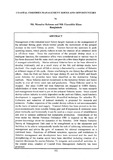| dc.contributor.author | Rahman, Md. Masudur | |
| dc.contributor.author | Khan, Md. Giasuddin | |
| dc.date.accessioned | 2019-06-25T09:03:04Z | |
| dc.date.available | 2019-06-25T09:03:04Z | |
| dc.date.issued | 1997 | |
| dc.identifier.citation | Rahman, Md. M., & Khan, Md. G. (1997). Coastal fisheries management issues and opportunities. In Proceedings of the Regional Workshop on Coastal Fisheries Management Based on Southeast Asian Experiences, Chiang Mai, Thailand, 19-22 November 1996 (pp. 102-118). Samut Prakarn, Thailand: Training Department, Southeast Asian Fisheries Development Center. | en |
| dc.identifier.uri | http://hdl.handle.net/20.500.12067/942 | |
| dc.description.abstract | Management of the industrial trawl fishery largely depends on the management of the artisanal fishing gears which restrict greatly the recruitment of the penaeid shrimps in the trawl fishery as adults. Trawlers harvest the spawners in peak spawning season, which greatly reduces in turn the chances of an enhanced stock in off-shore water. Since the exploitation of the penaeid shrimp stock is a multigear function, the cumulative affect were considered and in various ways it has been discussed that the same stock can provide a few times higher production if managed scientifically. Marine artisanal fisheries have so far been allowed to develop irrationally and as a result many of the fish and shrimp stocks have declined. One single stock of fish or shrimp is harvested by a number of fisheries at different stages of life cycle. Hence overfishing in one fishery has affected the others. Here the Push net fishery for tiger shrimp PL and the ESBN and Beach seine fisheries for juveniles have been identified as the destructive fishing methods. These fisheries restrict recruitment in the industrial fishery and hence results in over all lower catch rate and production. These fisheries need to be stopped. But since 55,000 full time fishermen are engaged in ESBN fishery, rehabilitation of them would be necessary before withdrawal. So main research and management thrust need to put on the artisanal fisheries sector. Since coastal shrimp culture industry is solely dependent on the push net fishery, rapid hatchery development is suggested. Meanwhile diversified technique for selective PL. Collection and reduction of induced mortality is proposed for research and extension. Further expansion of the coastal shrimp culture is not recommendable on the basis of natural seed supply. Trammel fishery has been proved to be bio-socio-economically most suitable fishing gear and if expansion & extension takes place vertically and horizontally it can be used as a major source of rehabilitation and also to enhance additional but sustainable production. Amendment of the rules under the Marine Fisheries Ordinance 1983 is required on the basis of present knowledge about the dynamics of the fisheries. DOF Marine Fisheries Survey & Management Unit need to be strengthened as to the manpower and facilities, to be able to independently handle the task of achieving information for management and advise the govt. of measures for rational management on a continued basis. Functions of different ministries, agencies and institutions in fisheries management and development have been reviewed and the need for strengthening of the marine sector have been identified including creation of a separate directorate for marine fisheries. To integrate and control all activities in the coastal areas, creation of Coastal Zone Management Authority has been proposed. | en |
| dc.language.iso | en | en |
| dc.publisher | Training Department, Southeast Asian Fisheries Development Center | en |
| dc.title | Coastal Fisheries Management Issues and Opportunities | en |
| dc.type | Conference paper | en |
| dc.citation.spage | 102 | |
| dc.citation.epage | 118 | |
| dc.citation.conferenceTitle | Proceedings of the Regional Workshop on Coastal Fisheries Management Based on Southeast Asian Experiences, Chiang Mai, Thailand, 19-22 November 1996 | en |

